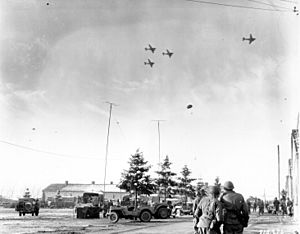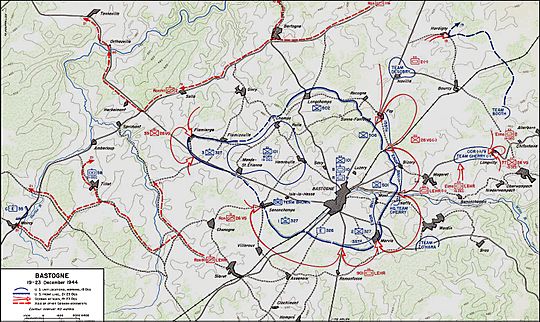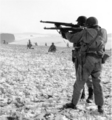Siege of Bastogne facts for kids
Quick facts for kids Siege of Bastogne |
|||||||
|---|---|---|---|---|---|---|---|
| Part of the Battle of the Bulge (World War II) | |||||||
 101st Airborne Division troops watch as C-47s drop supplies over Bastogne, 26 December 1944 |
|||||||
|
|||||||
| Belligerents | |||||||
| Commanders and leaders | |||||||
|
|
||||||
| Units involved | |||||||
|
Initially parts of:
|
Initially parts of:
|
||||||
| Strength | |||||||
|
Unknown | ||||||
| Casualties and losses | |||||||
| 3,000+ total casualties (2,000 in the 101st) | Unknown | ||||||
The siege of Bastogne was a major battle in December 1944. It took place in the Belgian town of Bastogne during the larger Battle of the Bulge in World War II.
The German army's main goal was to capture the harbor at Antwerp. To get there quickly, their powerful tank units needed to use the roads through eastern Belgium. All seven main roads in the Ardennes forests met at Bastogne. This made controlling Bastogne super important for the German attack.
The German attack started on December 16. Even though they were outnumbered, American soldiers held them back. This gave time for units like the 101st Airborne Division to reach Bastogne. The German forces then surrounded the town on December 20. Bad weather stopped Allied planes from bringing supplies or attacking German forces until December 23. The siege ended on December 26. A group from the 4th Armored Division broke through, opening a path to Bastogne.
Why Bastogne Was Important
After the Allies successfully landed in Normandy and pushed through France, their front lines stretched far. They had captured the important port city of Antwerp. By winter, they even controlled some German land.
Adolf Hitler then planned a surprise attack. He wanted 25 German divisions to push through the Ardennes. Their goal was to cross the Meuse river and recapture Antwerp. Many of his top commanders disagreed with the plan. But it went ahead on December 16, 1944.
Allied commanders thought the Ardennes area was too difficult for a big German attack. They also believed the German soldiers there were tired. So, no Allied commander expected an attack.
Bastogne was a central town with many important roads. It was mainly defended by the 28th Infantry Division. This division had fought hard for months and was resting in this quiet area. The Allies thought only a small German force was nearby. They believed any attack would be small. But the seven roads in and out of Bastogne were key for German tanks. So, the Allies had to keep control of them.
German Attack Plan
General Hasso von Manteuffel led the 5th Panzer Army. He ordered General Heinrich Freiherr von Lüttwitz to capture Bastogne. Lüttwitz planned to attack with three divisions. These were the 26th Volksgrenadier and the 2nd Panzer divisions. The Panzer Lehr Division would follow them.
Facing this large force were only two battalions of the 110th Infantry Regiment. They were spread out over a 9-mile front along the Our River. Allied soldiers were in small groups in villages. Outposts along the river were only manned during the day. The forces were too thin to form a strong battle line. They focused on the four roads crossing the Our.
Heavy rain made most roads unusable. Only one northern road was good enough to cross. The 2nd Panzer Division was to use this road. The 26th Volksgrenadier Division would build a bridge. Lüttwitz knew Bastogne's roads were vital. He ordered the Panzer-Lehr Division to push to Bastogne quickly.
The Battle Begins
First Attacks
On the night of December 15, German soldiers set up outposts on the Our River's west bank. This was a normal routine. At 3:00 AM, engineers started moving men and equipment across the river. They gathered close to the American positions. At 5:30 AM, German artillery began firing, cutting telephone lines. The infantry then started to advance.
The Germans attacked fast, using their huge numbers. In the village of Weiler, one American company fought until nightfall. They faced many German battalions. German engineers finished bridges before dark, and tanks moved to the front. This added to Germany's large number of soldiers. But the American defenders slowed the Germans down a lot. Their plan to cross the Clerf River on the first day was delayed by three days.
On December 19, the 28th Division moved its command post to Bastogne. The division made its last stand in Wiltz. A battalion of the 110th Regiment arrived there around noon. The 44th Engineer Battalion was set up north of Wiltz. But they were quickly overwhelmed and retreated into the town. They blew up a bridge behind them. This small American force, about 500 soldiers, held out until evening. Then, they had to retreat west. With the 110th Infantry badly damaged, other Allied units had to defend Bastogne.
Bringing in More Troops
The Ardennes Offensive was a complete surprise. By the second day, it was clear the 28th Infantry was almost defeated. To help defend Bastogne, Major General Troy H. Middleton received more troops. These were Combat Command B (CCB) of the 10th Armored Division.
General George S. Patton, who led the U.S. Third Army, was not happy about giving up this unit. He had planned his own attack. But General Omar Bradley ordered him to release the unit. Meanwhile, General Dwight D. Eisenhower, the top Allied commander, sent in his reserve troops. These included the 82nd Airborne Division and the 101st Airborne Division. These were experienced soldiers who had fought bravely in Normandy and the Netherlands. They were resting and getting new equipment.
Both divisions were told to move on the evening of December 17. They quickly found trucks to move forward. The 82nd Division, being better prepared, left first. The 101st left on December 18. Their convoy was very long, stretching for 120 kilometers. They drove at night in rain and sleet, using headlights to go faster.
The 101st Airborne was supposed to go to Werbomont. But they were sent to Bastogne instead, which was 107 kilometers away. The 705th Tank Destroyer Battalion was ordered to Bastogne to help the 101st Airborne, which had no tanks. They arrived late on December 19. The first soldiers of the 501st Parachute Infantry Regiment (PIR) reached Bastogne just after midnight on December 19. By 9:00 AM, the entire division had arrived.
Brigadier General Anthony McAuliffe sent the 501st PIR southeast through Bastogne. They met the Panzer-Lehr-Division and fought all day. The 506th PIR followed. One battalion went to Noville to help Team Desobry from the 10th Armored CCB. The other two battalions stayed as reserves north of Bastogne. The 502nd PIR went north to set up a defense line. The 327th Glider Infantry Regiment (GIR) protected the division's service area southwest of Bastogne.
Fighting at Noville
On December 19–20, the 1st Battalion of the 506th PIR helped Team Desobry. This was a tank-infantry group from the 10th Armored Division. They were defending Noville, just 4.36 kilometers north of Bastogne. With only four M18 Hellcat tank destroyers, the paratroopers attacked units of the 2nd Panzer Division.
The German division's mission was to go through Noville to capture a key highway and fuel dumps. Without fuel, the German attack would fail. The Germans worried about their left side near Bastogne. So, they launched a big attack to take Noville. The M18 Hellcat tank destroyers were very fast. They were able to get ahead of the enemy, just as they were designed to do.
The 1st Battalion and the tank destroyers destroyed at least 30 German tanks. They also caused 500–1,000 casualties. This made the German commander think Noville was held by a much stronger force. He stopped attacking the village. This was a big mistake. It greatly delayed the German advance. This delay gave the 101st Airborne Division enough time to set up defenses around Bastogne.
After two days, the 2nd Panzer Division finally continued its mission to the Meuse River. Because it got stuck at Bastogne, it ran out of fuel at Celles. There, it was destroyed by American and British forces.
By the time the 1st Battalion left Noville on December 20, the village of Foy had been captured by a separate German attack. The 1st Battalion had to fight its way through Foy. By the time they reached safety, they had lost many soldiers. Team Desobry also lost a quarter of its troops.
The Siege of Bastogne
The 101st Airborne Division set up a defense all around Bastogne.
- The 502nd PIR defended the northwest.
- The 506th PIR blocked entry from Noville.
- The 501st PIR defended the eastern side.
- The 327th Glider Infantry Regiment (GIR) was spread out along the southern side.
- Engineer and artillery units filled gaps in the line.
The division's service area west of Bastogne was attacked on the first night. They lost almost their entire medical company. Many support troops had to fight as infantry. CCB of the 10th Armored Division had lost many soldiers. It formed a mobile "fire brigade" with 40 tanks.
Three artillery battalions were brought together. They had twelve 155mm howitzers each. This gave the division strong firepower in all directions. But they had limited ammunition. Colonel Roberts, who led CCB, also gathered over 600 scattered soldiers. He formed them into a group called Team SNAFU to help defend.
Many artillery guns were used to fire directly at enemy tanks. Over 2,000 rounds were used this way on December 20. The division's anti-aircraft guns were also moved to the front lines. They fired at enemy tanks to help the 57mm anti-tank guns.
Because of the strong American defense, the German commander decided to surround Bastogne. He planned to attack from the south and southwest. This started on the night of December 20–21. German tank units had some early success. They almost overran American artillery positions. But a quickly formed American force stopped them. By noon on December 21, all seven highways leading to Bastogne were cut by German forces. By nightfall, the American soldiers were completely surrounded.
The American soldiers were outnumbered about 5 to 1. They lacked warm clothing, ammunition, food, and medical supplies. Many senior officers were also away. The terrible winter weather meant no supplies could be flown in. Air support was also impossible due to the clouds.
However, the two main German tank divisions continued their mission towards the Meuse River on December 22. They did not attack Bastogne with a single large force. They left only one regiment to help the 26th Volksgrenadier Division capture the crossroads. The German tanks probed different points of the southern and western defense line. Bastogne was defended by only one airborne regiment and support units acting as infantry. This helped the Americans. They could move their artillery fire and limited tanks to meet each attack.
On December 22, General von Lüttwitz sent a demand for surrender to the American commander in Bastogne, Brigadier General Anthony McAuliffe. The German message said that American forces were surrounded. It warned that if they did not surrender, German artillery would destroy the town. It also mentioned that civilian losses would be the Americans' fault.
McAuliffe's famous reply was short and defiant:
To the German Commander.
NUTS!
The American Commander
The commander of the US 327th Glider Infantry Regiment explained it to the Germans as "Go to hell!"
Despite this brave response, the Germans continued their attack. On Christmas Eve, the 26th VG Division received more troops for its main assault the next day. That night, German bombers attacked Bastogne. They killed 21 people in an aid station.
Because they didn't have enough fresh troops, the Germans focused their attack on a few spots on the west side of the perimeter. The attack, led by 18 tanks and infantry, broke through the lines of the 327th's 3rd Battalion. They reached the battalion's command post.
However, the 327th held its ground and fought off the infantry attacks. They captured 92 Germans. The German tanks that broke through split into two groups. One tried to reach Champs from the rear. But they were destroyed by two companies of the 1st Battalion 502nd PIR and four tank destroyers.
The Allies holding Bastogne was a huge problem for the German tank advance. News of the strong defense boosted the spirits of Allied forces everywhere.
Breaking the Siege
Parts of General George Patton's Third Army finally reached Bastogne from the southwest. The first tank, named Cobra King, made contact with the defenders on December 26 at about 4:50 PM. On December 27, the 101st Division's communication with American supply areas was restored. Wounded soldiers were then moved out of Bastogne. General Taylor arrived and took command again.
Even though there would be more fighting in Bastogne for several weeks, the siege itself was over once the path was opened.
What Happened Next
The 101st Airborne Division had many casualties from December 19, 1944, to January 6, 1945. They had 341 killed, 1,691 wounded, and 516 missing. Some regiments within the 101st were nicknamed "The Battered Bastards of Bastogne" for their brave defense.
For defending Bastogne, the 101st Airborne Division received the Presidential Unit Citation. They also received the Belgian Croix de Guerre 1940 with Palm.
The 10th Armored Division's Combat Command B had about 500 casualties. They also received the Presidential Unit Citation for their actions. Years later, General Anthony McAuliffe said that Combat Command B of the 10th Armored Division was not given enough credit for their important role.
Augusta Chiwy, a nurse who helped the wounded during the siege, was honored in December 2011.
Images for kids
-
Members of C Company, 9th Engineers, conduct a memorial service for those killed during the siege, 22 January 1945.








